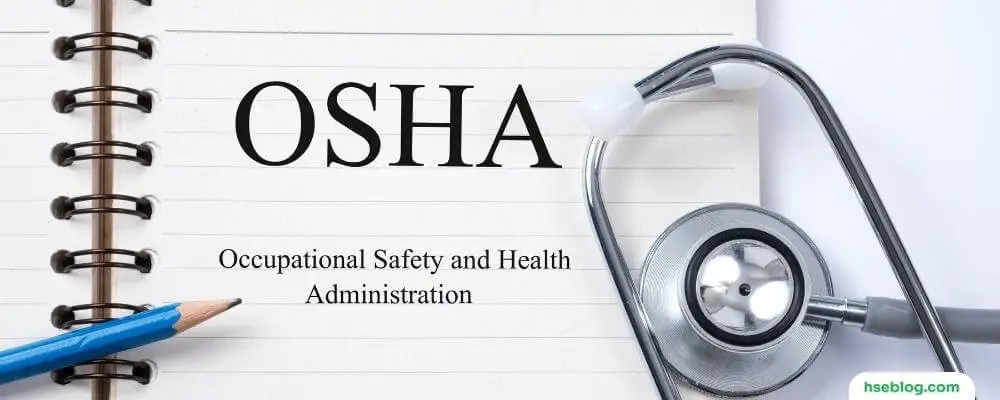Understanding the importance of safety and health in the workplace is fundamental for any worker or business owner. In the United States, this topic is largely governed by a single entity: the Occupational Safety and Health Administration (OSHA). In this blog post, we will look closely at what it is, explore its primary purpose, and discuss why its role is critical for every American worker and employer.
OSHA’s impact extends far beyond safety helmets and hazard signs; it plays a fundamental role in maintaining the quality of American working life. Whether you’re an employer aiming to comply with safety regulations, or an employee seeking to understand your rights and protections, this blog post is for you. Read on to discover the pivotal role OSHA plays in shaping and safeguarding workplaces nationwide.
What is OSHA?
The Occupational Safety and Health Administration (OSHA) is a federal United States Department of Labor agency. Established by Congress in 1971, OSHA’s mission is to ensure safe and healthy working conditions for workers in the U.S. by setting and enforcing standards and providing training, education, and assistance. The agency oversees all types of workplaces and is responsible for enforcing various safety and health regulations, ranging from ensuring the use of protective equipment to limiting exposure to hazardous substances.
Although random inspections also take place, OSHA has the authority to inspect workplaces, often in response to reported violations or workplace incidents. If a violation of safety standards is discovered, OSHA can impose penalties, including significant fines. The agency also provides training and education services to help employers understand and meet their obligations under OSHA standards and help workers understand their rights and how to ensure their safety.
The significance of OSHA lies in its core mission to protect the health and safety of workers. OSHA helps prevent workplace injuries, illnesses, and deaths through its regulations and enforcement. This creates safer work environments, ensures fair treatment for workers, and can lead to productivity and financial benefits for employers. So, whether you’re an employee or an employer, OSHA plays a crucial role in your work.

What’s The Purpose Of OSHA?
The primary purpose of the Occupational Safety and Health Administration (OSHA) is to ensure that all workers in the United States have a safe and healthy work environment. To achieve this, OSHA sets and enforces standards that employers must adhere to to minimise risks of work-related injuries, illnesses, and fatalities. These standards cover various aspects, such as handling hazardous materials, machine guarding, and protective equipment use.
OSHA also conducts workplace inspections to ensure compliance with the set standards. These inspections can be in response to a reported violation, a workplace incident, or as part of routine checks. If non-compliance is found, OSHA has the authority to issue penalties, including fines and, in severe cases, criminal charges. The goal is to encourage employers to maintain safe workplaces and to deter potential violations.
Beyond enforcement, OSHA serves an educational purpose. The agency provides extensive training, outreach, and education to both employers and workers. This helps employers understand and fulfil their responsibilities and empowers workers to know their rights, safety practices, and procedures. The ultimate aim is to foster a safety culture in all workplaces, reducing work-related hazards and enhancing the well-being of America’s working population.

Why Is OSHA Important?
OSHA, which stands for the Occupational Safety and Health Administration, is an important regulatory agency in the United States that plays a crucial role in ensuring workplace safety and health. Here are several reasons why OSHA is important:
- Protecting Workers: OSHA’s primary purpose is to ensure the safety and well-being of employees in the workplace. It sets and enforces standards to prevent work-related injuries, illnesses, and fatalities. By establishing regulations and guidelines, OSHA helps create safer working conditions and reduces the risk of accidents, hazards, and exposure to harmful substances.
- Workplace Hazard Identification and Prevention: OSHA conducts inspections and assessments of workplaces to identify potential hazards and risks. Through its standards and guidelines, it helps employers identify and address these hazards effectively. OSHA also provides resources and information to educate employers and workers about best practices for hazard prevention, such as proper safety procedures and personal protective equipment (PPE).
- Training and Education: OSHA promotes training and education on workplace safety and health. It provides resources, courses, and materials to enhance the knowledge and awareness of employers and employees. OSHA’s training programs cover many topics, including hazard recognition, emergency preparedness, machine safety, ergonomics, etc. By improving knowledge and skills, OSHA helps prevent accidents and creates a workplace safety culture.
- Compliance and Enforcement: OSHA can enforce its safety and health standards. It conducts inspections to ensure that employers comply with the regulations and can issue citations and penalties for violations. This enforcement mechanism encourages employers to prioritize safety and take necessary measures to protect workers. By holding employers accountable, OSHA helps deter negligence and promotes a safer work environment.
- Data Collection and Research: OSHA collects data on workplace injuries, illnesses, and fatalities, providing valuable information for research and analysis. This data helps identify trends, emerging hazards, and areas where additional regulations or interventions may be needed. It also enables OSHA to evaluate the effectiveness of existing standards and revise them if necessary, leading to continuous improvement in workplace safety.
Overall, OSHA’s importance lies in its mission to safeguard workers’ well-being, prevent workplace hazards, provide education and training, enforce compliance, and contribute to ongoing research and development in occupational safety and health. By doing so, OSHA is vital in reducing injuries, illnesses, and fatalities in American workplaces.

Different pieces of training Offered By OSHA
OSHA offers various training programs and educational resources to help employers and workers understand and comply with workplace safety and health requirements. Here are some of the leading training initiatives:
- OSHA Education Centers: These are non-profit organizations authorized by OSHA to deliver occupational safety and health training to the public. They offer courses on various topics, such as construction and general industry safety and health standards, industrial hygiene, and safety and health management.
- OSHA Outreach Training Program: This program provides workers with basic and more advanced training about standard safety and health hazards in the workplace. The program offers 10-hour or 30-hour classes for Construction, General Industry, Maritime, and Disaster Site work.
- OSHA Training Institute (OTI) Education Centers: These education centres offer training courses for safety and health professionals and educators who wish to teach the OSHA 10-hour and 30-hour Outreach Training classes.
- Online Training: OSHA provides a variety of online courses, including a series of interactive, web-based training tools on topics like hazard identification, machine guarding, and ergonomics.
- Hazardous Waste Operations and Emergency Response (HAZWOPER) Training: This specialized training is for workers involved in clean-up operations, voluntary clean-up operations, emergency response operations, and storage, disposal, or treatment of hazardous substances or uncontrolled hazardous waste sites.
- Susan Harwood Training Grants: Named in honour of a former director of the Office of Risk Assessment, these grants are given to non-profit organizations to provide training and education programs for employers and employees on the recognition, avoidance, and prevention of safety and health hazards in their workplaces.
- OSHA 30-Hour Training: This is a more comprehensive version of the OSHA 10-hour training course. These courses are not mandatory for everyone. The OSHA 30-Hour Construction, an extensive course, provides detailed training to your employees with significant responsibilities, such as supervisors and superintendents.
Please note that not all training claiming to be from OSHA is authorized or recognized by OSHA. It’s important to verify the legitimacy of any training program or provider before signing up.
In conclusion, OSHA is an essential institution dedicated to safeguarding workers’ health and safety across the United States. Its mission, to prevent work-related injuries, illnesses, and deaths, is a testament to its pivotal role in every working sector. Through setting and enforcing regulations, conducting inspections, and offering a wide array of educational resources and training programs, OSHA continually works towards enhancing workplace safety standards.
As an employer or an employee, understanding the role of OSHA and the resources it provides can not only ensure legal compliance. Still, it can significantly contribute to a safer, healthier, and more productive working environment. Remember, safety is a shared responsibility, and with OSHA’s guidance, we can all contribute to making American workplaces safer and healthier for everyone.
Let’s prioritise safety and health because every worker has the right to return home safe and sound at the end of each working day. Stay tuned to our blog for more insights and information on workplace safety and related topics.
Safety Practices and Compliance Requirements
Through these courses, OSHA provides Safety Practices and guides about the Compliance Requirements your organization has to meet. They are listed below:
Safety Practices
OSHA offers the best safety practices in its courses that are mandatory for your employees to implement.
Identification of risks
OSHA provides in-depth hazard identification techniques for each industry (construction, agriculture and forestry, maritime industry health care, etc.)
After taking these courses, your employees will be effectively able to identify hazards at the workplace. This includes recognizing physical, chemical, biological, and ergonomic hazards that may threaten employee safety and health. To get a broader perspective on the impacts of potential hazards and risks, understanding workplace safety facts is essential.
Identification is the first step towards responding to dangers promptly. If employees are able to identify risks, only then they will be able to strategize against them.
Hazard Prevention and Control
The program provides in-depth knowledge on preventing and controlling workplace hazards.
The prevention strategies are tailored, keeping in mind the needs of your employees and the company’s requirements. This involves implementing safety measures, engineering controls, and personal protective equipment (PPE) to mitigate risks.
Prevention of Health Hazards:
Since the work nature of most organizations requires employees to work in severe environmental and weather conditions, their hands-on experience with the environment and equipment exposes them to several health risks. Osha courses educate employees about all the health conditions so they can at least manage them.
Dealing with emergencies:
Most workplace encounters are emergencies. They are inevitable. However, if the employees are well equipped with the necessary equipment and tools, the consequences of the crisis can be reduced.
OSHA10-Hour and 30-hour training courses cover emergency response protocols, including evacuation procedures, first aid, and emergency contact information.
Protects mental health
As you may know already, working in harsh conditions takes a toll on the mental health of workers. OSHA acknowledges this reality and follows the guidelines set by the World Health Organization to safeguard employees’ mental health. It delivers a stress-free working environment by implementing research-backed methods to ensure a well-balanced state of mind for your employees.
Compliance Requirements
If your employees complete their OSHA training courses, they will be able to meet the requirements that are essential for a safe workplace environment. A few of these requirements are listed below:
Adherence to safety protocols
Showing compliance with safety standards can be complicated as each category is divided into further categories. OSHA simplifies these protocols so they are easy to understand and then implement.
Safety Program Development:
For a hazard-free workplace, a safety program is essential. The safety programs identify physical, chemical, biological, and ergonomic hazards that may threaten employee safety and health. OSHA guides your workers in developing the safety program and then implementing it to meet the safety standards.
Following consistent training sessions
Employees are required to take training sessions consistently to comply with OSHA requirements. Those who have completed their 10-hour course can take the 30-hour course after a gap of a few months. After completion of courses, reinforcement is equally important to help them identify their strengths and weaknesses.

